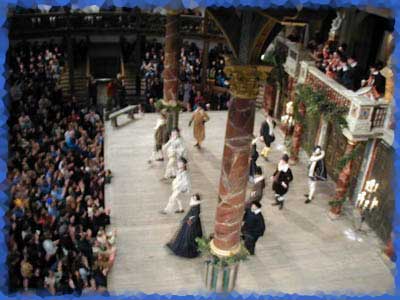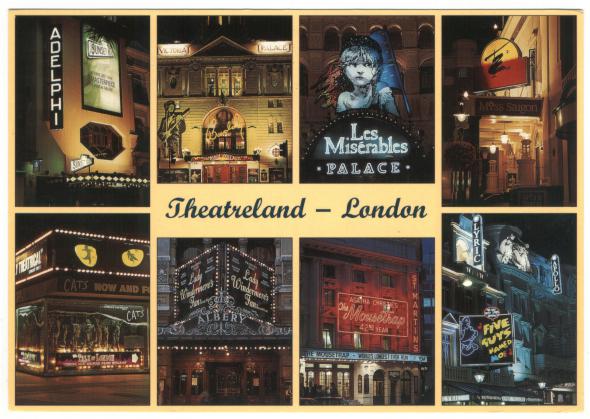
- •Ббк 85.33:81.2 Англ я7
- •Введение
- •Introductory part
- •Voice in the performing art
- •Голос и речь в сценическом искусстве
- •Советы при работе с текстом
- •Стихи как один из видов голосового тренинга
- •Междометия в постановке голоса
- •1. «Прыгуны» - алле – гоп!
- •2. «Пильщики» - с! с! с!
- •8. «Победительницы» - Ай да!
- •9. «Шутка» - Ав-ав!
- •10. «Звукоподражатель».
- •I’ve got a little horse.
- •English intonation
- •A n Extract from the Book by Jerome k. D.
- •“Three Men in a Boat (To Say Nothing of the Dog)”
- •Отрывок из книги д. К. Джерома
- •«Трое в лодке, не считая собаки»
- •Phonetic exercises
- •Genres of theatre
- •Voltaire (1694-1778)
- •Visiting the theatre
- •A t the broadway theatre
- •Phrase-list Performing Arts
- •Conversation
- •E arly theatres
- •British theatres
- •Theatres in shakespeare’s time
- •British theatres today
- •T heatre in russia
- •A new theatre was born
- •Looking for new ways
- •Great actors
- •Sir laurence olivier
- •T he great comedian
- •M ovies, movies, movies
- •The art of transformation
- •B rad pitt
- •S moktunovsky and english
- •Theatre traditions
- •Interviewing an actor
- •Literature and drama
- •William shakespeare
- •Richard sheridan
- •T he myth of pygmalion
- •My fair lady
- •O scar wilde
- •John james osborne
- •Bertold brecht
- •Anton chekhov
- •E ugene gladstone o'neill
- •Tennessee williams
- •George gordon byron
- •Charles dickens
- •Music of the united kingdom
- •Edward benjamin britten
- •Andrew lloyd webber
- •M usic of the united states
- •George gershwin
- •T he proms
- •Music and youth culture
- •Rock & roll
- •R eggae
- •Beatboxing
- •Music genres of the youth
- •I nsomniac
- •British songs
- •Auld lang syne Scottish Song
- •Перевод с. Я. Маршака
- •Bobby shaftoe English Folksong
- •Charlie is my darling Scottish Folksong
- •Cockles and mussels
- •Irish Song
- •I saw three ships come sailing by English Folksong
- •Home, sweet home English Song
- •Land of my fathers Welsh Song
- •My bonnie British traditional song
- •O, no, john! English Folksong
- •Перевод с. Болотина и т. Сикорской
- •There was an old woman English Folksong
- •Перевод с. Я. Маршака
- •There’s a hole in my bucket Popular Folk Song from Britain
- •Greensleeves English Folk Song
- •Перевод с. Я. Маршака
- •For he’s a jolly good fellow Popular English Social Song
- •Twelve days of christmas
- •Amazing grace
- •A red, red rose
- •Перевод д. Тим
- •Author Unknown
- •American songs
- •Jingle bells
- •Billy boy
- •Oh, my darling, clementine
- •We shall overcome
- •Перевод с. Болотина и т. Сикорской все преодолеем
- •What a wonderful day
- •Перевод а. Дюка Прекрасный мир
- •From the history of british paiting
- •An american style of painting
- •Pablo picasso
- •Issac levitan
- •Theatre and stage design
- •Stage designer
- •Favorsky as a stage designer
- •P hotography
- •Conversations
- •Presentation
- •P art eight theatrical sketches small talk
- •Informal Greetings
- •Invitations
- •English business etiquette
- •English weather
- •E nglish humour
- •Funny stories and jokes Math, Physics, & Philosophy
- •Sherlock Holmes and Watson
- •Genie in the Lamp
- •Magician
- •Lippy Parrot
- •Small talk
- •Projects
- •Appendix 2
- •The Performing Arts: a Guide to the Reference Literature / Linda Keir Simons, 1994. Заключение
- •Contents
- •Зинаида Евгеньевна Фомина искусство как средство изучения английского языка
- •394006 Воронеж, ул. 20-летия Октября, 84.
E arly theatres
The first buildings used for theatrical performances in Britain were amphitheatres introduced by the Romans, who copied theatres from ancient Greece. These were semi-circular structures, constructed of wood initially and later rebuilt in stone. They were open to the air with banked seating surrounding a raised stage.
Medieval theatre was presented on elaborate temporary stages inside great halls, barns, or in the open courtyards of galleried inns. It was from these that Elizabethan timber-framed open-air theatres took their form, such as the Globe in London. They were multi-sided buildings, with a covered platform stage against one side. The audience sat or stood in covered galleries around the other sides or in the open courtyard. All the performances took place in daylight.
British theatres
Until recently the history of the English theatre has been build around actors rather then companies. It has been hard to find any London theatre that even had a consistent policy. There is no permanent staff in British theatres. Apply is rehearsed for a few weeks by a company of actors working together mostly for the first time and it is allowed to run as long as it draws the odious and pays it's way. Another peculiarity of the theatres in Great Britain is as follows: there are two kinds of seats, which can be booked in advanced (bookable), and unbookable once have no numbers and the spectators occupy them on the principal: first come - first served. And ancient time’s plays were acted inside churches and later on the market places. The first theatre in England “The Blackfries” build in 1576, and “The Globe” build in 1599, which is closely connected with William Shakespeare. Speaking about our times we should first of all mention “The English National theatre”, “The Royal Shakespeare Company” and “The Covent Garden”. “Covent Garden” used to be a fashionable promenade - it was, before then, a convent garden - but when it became overrun with flower-sellers, orange-vendors and vegetable-growers, the people moved to more exclusive surroundings farther west, such as “St. James’s Square”. The first “Covent Garden theatre” was built in 1732. It was burnt down in 1808 and rebuilt exactly a year after. It opened in September 1809, with Shakespeare's “Macbeth”. Since the middle of the last century “Covent Garden” became exclusively devoted to opera. Now “Covent Garden” in busier than ever, it is one of the few well-known opera houses open for 11 months of the year and it employs over 600 people both of the Opera company and the Royal Ballet.

Theatres in shakespeare’s time
At the time when Shakespeare (1564-1616) was creating his masterpieces the theatres in which they were staged had little in common with the theatres of today. They were usually round in shape, had high walls and no roof. The stage was part of the pit so that the actors could speak in a natural voice. During the performance poor spectators watched it from the pit while the aristocrats sat on the stage just where the action of the play was taking place. An iron fence surrounded the pit. It protected the spectators in the boxes when wild beasts sometimes took part in the performance. The scenery was unusual too. They used simple boards with such inscriptions as “This is the moon”, “Here is the castle of Elsinore”, etc.
A trumpeter announced the beginning and the end of a play. The stage had no curtain and when a character died, the other actors carried him off the stage.
Questions:
What were theatres like when Shakespeare was creating his masterpieces?
What was the shape of the theatres?
What spectators filled the pit?
Where were the aristocrats sitting during the performance?
What was the scenery like?
How did they announce the beginning and the end of the play?
What modern theatres can you name that have no curtain and don’t use any scenery?

